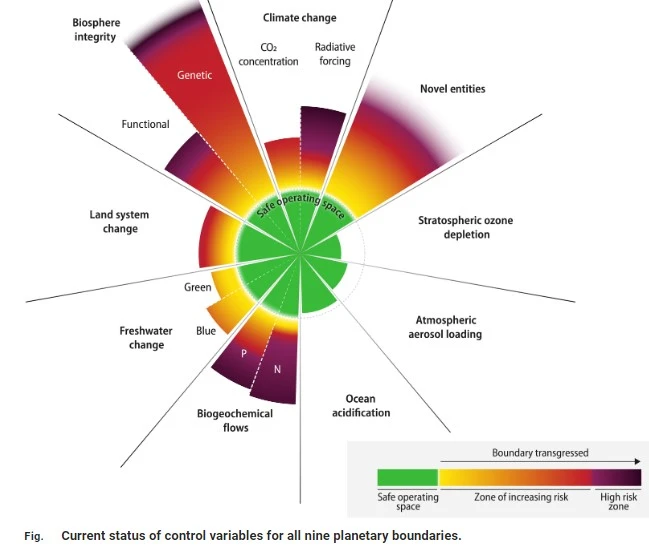Planetary Boundaries Framework: Concept and Significance
Context: The 2024 Tyler Prize for environmental achievement was awarded to Johan Rockstrom for his pioneering work in the development of the Planetary Boundaries Framework.
- He had led the team of international researchers who originated the planetary Boundary Framework in 2009.
- The prestigious Tyler Prize is often described as Nobel Prize for environment.
Analysis
The Concept of Planetary Boundaries Framework
- What are the boundaries for a “safe operating space for humanity” on Earth, and what changes can we force on it before we trigger rapid, catastrophic environmental harm?
- In 2009, Sweden’s Stockholm Resilience Centre published the Planetary Boundaries Framework, which outlined nine key processes, influenced by humanity, that threaten the stability of the entire Earth System. These are:
- climate change (CO2 concentration and radiative forcing),
- biodiversity integrity (functional and genetic),
- ocean acidification,
- atmospheric aerosol loading,
- stratospheric ozone depletion,
- biogeochemical flows of nitrogen and phosphorus,
- freshwater change (blue water and green water),
- land-system change, and
- release of novel chemicals (including heavy metals, radioactive materials, plastics, and more).
- Together, the stability of these nine processes is essential to maintaining the Earth’s atmosphere, oceans and ecosystems in the delicate balance that has allowed human civilizations to flourish.
- Crossing boundaries increases the risk of generating large-scale abrupt or irreversible environmental changes.
The 2023 Update
- In 2023, the latest update not only quantified all boundaries, it also concludes that six of the nine boundaries have been transgressed. These are:
- climate change (CO2 concentration and radiative forcing),
- biodiversity integrity (functional and genetic),
- biogeochemical flows of nitrogen and phosphorus,
- freshwater change (blue water use and green water),
- land-system change, and
- release of novel chemicals (including heavy metals, radioactive materials, plastics, and more).

Read also: Model Code of Conduct (MCC) Explained: Features and Significance
Glossary
A) Blue Water Vs Green Water
- From a scientific perspective, there are two types of freshwater on earth: bluewater and green
- Blue water is water in rivers and lakes, groundwater and the water frozen in glaciers and the polar ice caps.
- Green water is the water available in the soil for plants and soil microorganisms. It is the water absorbed by roots, used by plants, and released back to the atmosphere through the process of transpiration.
- Green water can also leave the soil through evaporation or subsurface runoff, but it is considered productive only when it is used for plant transpiration.
- Note: Grey water includes all the wastewater without faecal matter (toilet water) generated from domestic streams, such as kitchens, and bathroom.
B) Climate Sensitivity
- Climate sensitivity is a term used by the Intergovernmental Panel on Climate Change (IPCC) to describe to what extent rising levels of greenhouse gases affect the Earth’s temperature.
- Specifically, it describes how much warmer the planet will get if the amount of greenhouse gases in the atmosphere
C) Functional Biodiversity
- Functional diversity is a component of biodiversity that generally concerns the range of things that organisms do in communities and ecosystems.
- Integrity is the degree to which biodiversity’s composition, structure, and function are similar to its natural or reference state.
D) Radiative Forcing
- Radiative forcing is what happens when the amount of energy that enters the Earth’s atmosphere is different from the amount of energy that leaves it.
- Energy travels in the form of radiation: solar radiation entering the atmosphere from the sun, and infrared radiation exiting as heat.
- If more radiation is entering Earth than leaving—as is happening today—then the atmosphere will warm up.
- This is called radiative forcing because the difference in energy can force changes in the Earth’s climate.
E) Atmospheric Aerosol Loading
- Atmospheric aerosol loading refers to the presence of suspended solid and/or liquid particles in the air, such as dust, smoke, and haze.
- This can be quantified either by measuring the mass concentration of these aerosol particles or by utilizing optical methods to gauge their presence.
F) Biogeochemical Cycles
- Biogeochemical Cycles are the pathways by which elements like carbon, phosphorus, nitrogen, and sulfur, or compounds like water, flow between living organisms and the environment.
G) Land Systems Change
- Land Systems Change refers to the human impact on landscapes, encompassing alterations such as deforestation, habitat destruction, and the transformation of natural environments into pastures, plantations, mining sites, roads, and various infrastructural developments
H) Earth Overshoot Day
- Earth Overshoot Day marks the date when humanity’s demand for ecological resources and services in a given year exceeds what Earth can regenerate in that year.
I) Plastic Overshoot Day
- The Plastic Overshoot Day marks the point at which the amount of plastics exceeds the global waste management capacity.
J) Ocean Acidification
- Ocean acidification refers to a reduction in the pH of the ocean over an extended period of time, caused primarily by uptake of carbon dioxide (CO2) from the atmosphere.
- However, ocean acidification does not imply that ocean waters will actually become acidic (i.e., pH < 7.0).
- Increased ocean temperaturesand oxygen loss act concurrently with ocean acidification and constitute the ‘deadly trio’ of climate change pressures on the marine environment.
K) Stratospheric Ozone Depletion
- When chlorine and bromine atoms come into contact with ozone in the stratosphere, they destroy ozone molecules. This is called Stratospheric Ozone Depletion.
- The stratosphere is the second major layer of the atmosphere and lies above the troposphere, the lowest layer. It occupies the region of atmosphere from about 12 to 50 km above the Earth’s surface, although its lower boundary tends to be higher nearer the equator and lower nearer the poles.
L) Climate Change
- Climate change refers to long-term shifts in temperatures and weather patterns. Such shifts can be natural, due to changes in the sun’s activity or large volcanic eruptions.
- But since the 1800s, human activities have been the main driver of climate change, primarily due to the burning of fossil fuels like coal, oil and gas.
References:
- https://www.stockholmresilience.org/research/planetary-boundaries.html
- https://www.downtoearth.org.in/news/environment/planetary-boundary-pioneer-johan-rockstrom-wins-2024-tyler-prize-for-environmental-achievement-94752
- https://climate.mit.edu/explainers/radiative-forcing
- https://climate.mit.edu/explainers/climate-sensitivity
- https://www.eionet.europa.eu/gemet/en/concept/15062#:~:text=Definition,or%20by%20an%20optical%20measure
- https://www.science.org/doi/10.1126/sciadv.adh2458
Practice Questions:
Q1. With reference to the Planetary Boundaries Framework, consider the following statements:
- It was introduced by the International Union for Conservation of Nature (IUCN) to assess Earth’s capacity to support life and maintain stability.
- There are nine identified planetary boundaries, including climate change, biodiversity loss, and ocean acidification, among others.
- It suggests that once a boundary is crossed, it could lead to abrupt and irreversible environmental changes with severe consequences.
How many of the above statements are correct?
(a) Only one
(b) Only two
(c) All three
(d) None
Answer: b
Explanation:
- The Planetary Boundaries Framework was not introduced by the International Union for Conservation of Nature (IUCN). It was proposed by a group of Earth system scientists led by Johan Rockstrom in 2009. Hence, statement 1 is not correct.
- There are nine identified planetary boundaries which include climate change, biodiversity loss, ocean acidification, ozone depletion, freshwater use, land-system change, chemical pollution, atmospheric aerosol loading, and novel entities. Hence, statement 2 is correct.
- The Planetary Boundaries Framework suggests that once a boundary is crossed, it could lead to abrupt and irreversible environmental changes with severe consequences. This concept highlights the importance of staying within these boundaries to ensure the sustainability of the planet. Hence, statement 3 is correct.
Hence, only two of the statements given above are correct.
Therefore, option (b) is the correct answer.
Relevance: The 2024 Tyler Prize for environmental achievement was awarded to Johan Rockstrom for his pioneering work in the development of the Planetary Boundaries Framework.
Subject: Current Affairs | Science and Technology
Tags: Factual | Moderate Difficulty
Q. How can the application of the Planetary Boundaries Framework contribute to sustainable development and environmental policy-making in India, considering its unique socio-economic and ecological landscape? (Answer in 250 words)
Introduction:
- India, with its diverse socio-economic and ecological landscape, faces significant challenges in achieving sustainable development while preserving its natural resources.
- The application of the Planetary Boundaries Framework can provide a systematic approach to address these challenges by identifying critical environmental thresholds and guiding policy-making towards sustainable outcomes.
Assessing Environmental Limits:
- By adopting the Planetary Boundaries Framework, India can systematically assess its environmental limits across various dimensions such as climate change, biodiversity loss, and freshwater use.
- For instance, India’s ambitious renewable energy targets align with efforts to mitigate climate change, a crucial boundary within the framework.
- Additionally, initiatives like the National Mission for Clean Ganga aim to address freshwater use and water quality concerns, contributing to the preservation of vital ecosystems.
Informing Policy Formulation:
- Utilizing the framework can inform evidence-based policy formulation tailored to India’s specific context.
- For example, policies promoting sustainable agriculture practices align with the biodiversity boundary, ensuring the conservation of ecosystems essential for food security.
- Similarly, regulations addressing air pollution in urban centers contribute to staying within the atmospheric aerosol loading boundary, safeguarding public health and environmental integrity.
Balancing Socio-Economic Development:
- The Planetary Boundaries Framework emphasizes the interdependence between socio-economic development and environmental sustainability.
- In India, initiatives like the Sustainable Development Goals (SDGs) align with the framework’s principles, promoting inclusive growth while minimizing environmental impacts.
- For instance, promoting renewable energy adoption not only mitigates climate change but also fosters economic growth and energy security.
Addressing Environmental Justice:
- The application of the framework can enhance environmental justice by ensuring equitable distribution of resources and minimizing environmental degradation in vulnerable communities.
- For instance, policies promoting sustainable urban planning and access to clean energy in marginalized communities address both climate change and social equity concerns.
Conclusion:
- Incorporating the Planetary Boundaries Framework into India’s sustainable development agenda offers a holistic approach to address environmental challenges while fostering socio-economic progress.
- By systematically assessing environmental limits, informing policy formulation, balancing socio-economic development, and promoting environmental justice, India can pave the way towards a more sustainable and resilient future.

